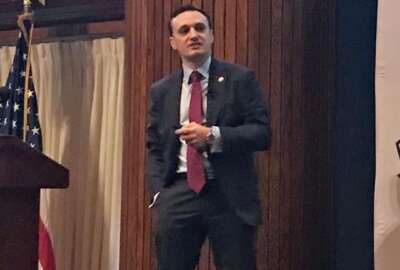Air Force pushes automated data sharing under draft strategy
The service is still pulling and sharing data manually in many cases. The Air Force's chief information officer wants to change that.
The Air Force is drafting a new automation strategy to help guide the service’s investments in areas like robotic process automation, with an eye toward quickly passing data between systems without needing a human to do the work.
Air Force Chief Information Officer Lauren Knausenberger said the service is still flushing out the strategy. During an Air Force IT Day hosted by AFCEA Nova in Arlington, Virginia, last week, Knausenberger told Federal News Network it’ll probably be several more months before it’s coordinated and signed out.
But she said a big part of the strategy is automating the movement of data.
“When we’re talking about moving data, or talking about visualizing data, we want to do more and more with feeds that are automatically sending data to where it needs to go, rather than having operators have to get into loops,” Knausenberger said. “So we still do have a problem with that in certain places, or you know we’re passing data via chat in certain places.”
The Air Force is working with the other military services on the Joint All Domain command and control concept. A key goal of JADC2 is increasing automation and linking sensors and weapon systems by quickly passing data between them.
But beyond the headlines about artificial intelligence and machine learning on the battlefield, the Air Force is already pushing automation across its back office and broader enterprise. The stated goal is to make life easier for airmen, guardians and civilians. And some leading tech companies are also emphasizing that potential and their pitches to the Defense Department.
“Drones and autonomous killer robots sound great, but I think the reality is we have an opportunity to remove so much toil from the lives of our airmen from the lives of our soldiers, our guardians, our Marines, and our sailors,” Google DoD Chief Technology Officer Sean Maday said during the AFCEA event. “The systems they’re using today are inefficient, they’re slow, and they have not great user experience.”
The Air Force recently established a Robotic Process Automation Center of Excellence under the Program Executive Office for business and enterprise systems. Earlier this month, leaders from the Center of Excellence went on a “Robotic Process Automation Roadshow” to provide airmen with RPA training.
In many cases, Knausenberger said the Air Force is simply catching up to commercial industry.
“There are some manual jobs that we are still doing because we have not made the type of investments that a lot of industry has made to provide that automation, that really awesome software,” she said. “We have a crazy amount of technical debt. We have a large number of different systems that sometimes do the same thing. We know this, we’re on it. We’ve done the analysis, we’re trying to rationalize. We never have enough capital to invest to do it as fast as any of us would like to see it. It’s just a matter of putting the plan to action.”
Last year, the Air Force “Vice Chief’s Challenge” asked service members for ideas on what parts of their jobs could be automated. It was called the “Saving Airmen Time” challenge.
“We were jokingly referring to it as the dear AI robot please come take this part of my job challenge,” Knausenberger said the AFCEA event. “There are some things that humans just don’t want to do. It puts us to sleep.”
The service picked 15 winning proposals, including a customer service chat bot that could field financial questions at Air Education Training Command. Another winner proposed introducing software that could automate squadron flying schedules, and a proposal from Air Force Headquarters suggested automating data collection to help fix systemic problems in the Air Force childcare program.
Knausenberger said those projects are now in various stages of implementation. She wants to get the Air Force to the point where it’s making RPA applications easily available across the service as part of its cloud environment.
“What I’d like to get us to is for robotic process automation is, here are the products that are accredited for our networks. Let’s have them available and easily consumable in cloud one,” she said. “And let’s have industry be thinking as part of their solutions, ‘How do I use those enterprise services to help you?’”
Knausenberger cited a project her office is working on for Air Force Security Forces. Case workers there were struggling to adjudicate criminal cases because they have to pull information from multiple databases. The RPA Center of Excellence is now working with them to help automate the data collection.
Knausenberger said the project isn’t just a good exercise in the utility of automation, but also the ethics of how much to rely on the technology.
“No one wants a bot to replace the judgment that someone has in determining how serious a crime was or like what a punishment should be, or indexing something in criminal justice with the FBI for an Airman,” she said. “But we do need our caseworkers to be able to process more than eight cases a day. It is taking them too long because they have to go to so many different places to get their information.
Similar data access challenges exist across the Defense Department. As the Air Force works through its broader automation strategy, Knausenberger sometimes patching those problems with a bot won’t be the final answer.
“Sometimes it’s a great interim answer on our way to assessing what is wrong with our software that got us there in the first place, and helping us to design those future software flows,” she said. “Because if that bot is having to take like 20 different steps to get to something, why does a bot have to do that? Why wasn’t the information just pulled from all of those data sources automatically to provide a report that is in the same format every single time for that case officer? Sometimes RPA is just a way of seeing our picture better on our way to what the real end solution is, which is probably better software.”
Copyright © 2025 Federal News Network. All rights reserved. This website is not intended for users located within the European Economic Area.
Follow @jdoubledayWFED






